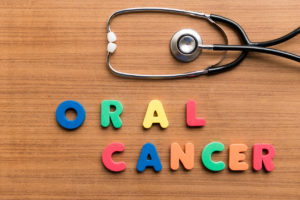
We are here this week, not to make you paranoid, but to inform you about a serious, although rare, disease of the oral cavity: oral cancer. According to the American College of Prosthodontists, early detection offers the greatest chance of survival of oral cancer, but only one-third of cases are found and treated during the early stages. We want to teach you about the steps that your dentist takes to evaluate your mouth for oral cancer at its earliest stages. We also want to teach you about some of the common lumps and bumps that can be found in the mouth that are harmless. We do not want you to think that something innocuous is actually cancer. At the same time, we don’t want you to dismiss a bump as just an irritation if it is actually something more serious. Your dentist is an expert on the oral cavity. If you have any questions or concerns about a new lesion in or around your mouth, you should consult you dentist as soon as possible. Oral cancer is relatively rare, but it still affects over 40,000 Americans each year.
Here at Ponte Vedra Complete Dentistry, we are dedicated to patient education and we wrote this blog so that you can learn about oral cancer. Did you know that we write new blogs every few weeks about the topics that our patients are most eager to learn about? If you are suspicious about a bump that you have in or around your mouth, please feel free to contact us at any time electronically to make an appointment or call (904)285-7711. We are always accepting new patients from in an around the Ponte Vedra Beach community.
What Will Happen During My Oral Cancer Screening?
Did you know that every dentist should perform an oral cancer screening during his or her examination? Dr. Harth and Dr. Townsend perform extensive oral cancer screenings during their examinations. This head and neck exam happens quickly and you may not even realize that it is taking place. Your dentist will first examine the skin of your head and neck and feel around for any suspicious bumps or tender areas. He will be searching for swollen areas or lymph nodes in addition to moles or crusts in suspicious areas like the ears and lips. After this, your dentist will look and feel inside your mouth. He will be searching for suspicious white or red lesions and will feel around for a lump, which could indicate an infection or tumor. If your dentist sees anything that he or she suspects could be dangerous, he or she will recommend that you visit a dermatologist or specialist to further examine this problem. He or she may also make you aware of a semi-suspicious issue and then recommend monitoring it over time. A note will be placed in your chart so that the dentist is always sure to check back for further development or regression of the lesion. For more information on the head and neck examination, please watch this video from the American Dental Association.
Who Is Most At Risk For Developing Oral Cancer?
Cancer research has established multiple risk factors that can contribute to the development of cancers of the mouth and throat. Exposure to the sun increases development of cancers of the lips. If you spend a lot of time outdoors, be sure to use lip balm with SPF along with your regular sunscreen. Smokers are six times more likely to develop oral cancer than those who are tobacco-free. You can speak with your dental provider if you would like more information and tips for smoking cessation. Heavy alcohol drinkers are also at an increased risk for developing oral cancer. Finally, the Human Papilloma Virus (HPV), which is transmitted sexually, has recently been associated with cancer of the mouth and throat. If you know that you are HPV-positive, it is important that you inform your dentist of this and pay special attention to lesions that may develop in your mouth.
How Can I Tell If My Bump Is Cancerous?
The only way to be 100% sure that you bump is not cancerous is to have it biopsied by a dentist or surgeon and submitted to a laboratory for histological testing. Your dentist, however, is specially trained to distinguish benign, or non-cancerous, lesions from malignant, or cancerous, lesions. Some of the warning signs for oral cancer are red and white patches in and behind the mouth, mouth sores and ulcers that bleed easily or do not heal, and unexplained lumps in the neck, throat, or floor of the mouth. If you have any of these signs or symptoms, please visit your dentist as soon as possible for an examination.
We hope that you learned something new today about oral cancer and encourage you to share this information with your friends and family members, especially those who have a high risk. This article was not meant to alarm you, but to educate you. If you have any further questions, please contact us at any time electronically or call (904)285-7711.



